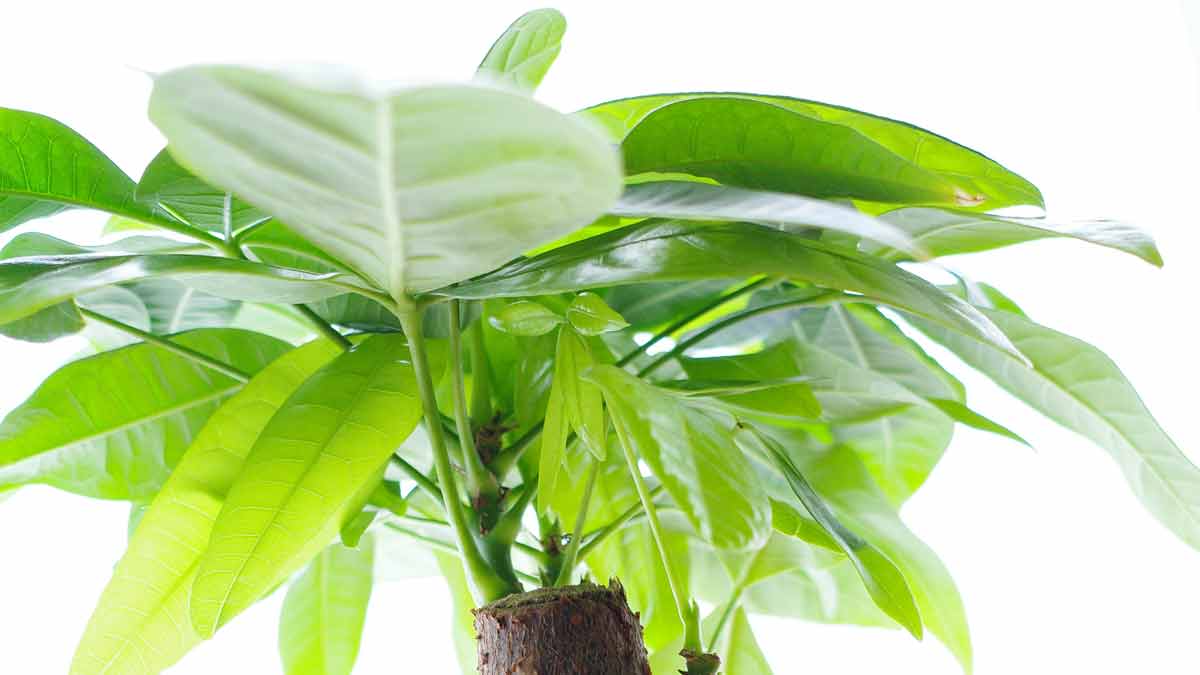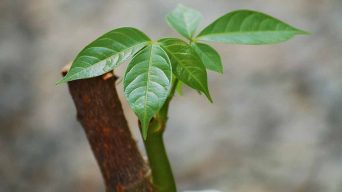Money Trees are beloved houseplants because they are easy to care for and have a beautiful, unique appearance.
However, sometimes Money Trees can run into problems like their leaves drooping.
This can be frustrating for gardeners, but don’t worry!
In this article, we’ll discuss the seven most common causes of drooping Money Tree leaves and how to fix them.
Why Are My Money Tree Leaves Drooping and How Can You Fix It?
There is often more than one reason why Money Tree leaves may droop, and it can be tricky to determine the exact cause.
Here are seven possible reasons for drooping leaves on your Money Tree plant and what you can do to fix the problem.
1. Lack of Water
When Money Tree leaves droop, it is often a sign that the plant is not getting enough water.
Water plays a vital role in a plant’s growth and development; without the proper balance of water, a plant will start to suffer.
Water transports dissolved sugar and other nutrients throughout the plant, and without enough water in the cells, the plant will droop.
In addition to being physically weakened, the plant will also be malnourished without the proper water balance.
How To Tell If Your Money Tree Needs Water
There are a few telltale signs that your Money Tree needs water, including:
- The soil is dry: This is the most obvious sign that your plant needs water. Money trees should be watered when the top inch of soil is dry to the touch.
- The leaves are yellowing or browning: Another telltale sign of a thirsty money tree is when its leaves start to turn yellow or brown. This is usually a result of underwatering, so give your plant a good drink if you see this happening.
- The leaves are wavy or curling: If the leaves of your money tree look wavy or curled, it could be a sign that they are not getting enough water. Money trees require high humidity, so you may also notice this problem if the air in your home is particularly dry.
- There is no new growth: Money trees typically grow pretty quickly, so if you see that your plant has stopped growing altogether, it might be because it’s not getting enough water.
How To Treat a Money Tree That Needs Water
If you think your Money Tree needs water, it is best to water it thoroughly.
To do this, ensure the pot has drainage holes so the water can drain out and the roots won’t become waterlogged.
Then, water the plant until the water runs out of the bottom of the pot.
You need to water your Money Tree deeply and infrequently to avoid overwatering, so be sure to let the soil dry out completely before watering again.
2. Too Much Water
Although it might seem counterintuitive, too much water can cause your Money Tree plant leaves to droop.
When a plant is overwatered, the roots start to suffocate because they are not getting enough oxygen.
This can lead to root rot, which can eventually kill the plant.
In addition, overwatering can cause the leaves of your Money Tree to turn brown or yellow and eventually drop off.
How To Tell If You Are Overwatering Your Money Tree
There are a few signs that you might be overwatering your Money Tree plant, including:
- The soil is constantly wet: One way to tell if you are overwatering your Money Tree is if the potting soil is always moist. Be sure to check the soil before watering to see if it needs more water or not.
- The leaves are yellowing or browning: Another sign of overwatering is if the leaves start to turn yellow or brown. If you see this happening, it’s best to cut back on watering and let the soil dry.
- The plant is wilting: Wilting is another common symptom of overwatering. If your plant looks wilted and droopy, it’s likely because it’s not getting enough oxygen.
- There is no new growth: If you notice that your Money Tree has stopped growing, it might be because it’s getting too much water.
- The leaves are dropping off: If the leaves of your Money Tree are falling off, it is a sign that the plant is stressed and might be overwatered.
- There are mushy or black roots: One of the most severe signs of overwatering is when the roots start to rot. This can happen if the roots are constantly sitting in water, so check the roots periodically to ensure they are healthy.
How To Treat an Overwatered Money Tree
If you think you might be overwatering your Money Tree, the best thing to do is to let the plant dry out for a few days.
To do this, stop watering the plant and let the soil dry out completely. Once the soil is dry, you can start watering again as usual.
When you do water, be sure to water deeply and infrequently to avoid overwatering in the future.
You may need to repot your plant if the roots have started to rot.
3. Low Humidity
Low humidity is another common cause of Money Tree leaves drooping.
These plants prefer high humidity, so if the air in your home is particularly dry, it can cause the leaves to droop.
The low humidity causes the plant to lose water through its leaves, leading to wilting and, eventually, leaf drop.
How To Tell If Your Money Tree Needs More Humidity
There are a few signs that your Money Tree plant might need more humidity, including:
- The leaves are drooping: One of the most common signs that your Money Tree needs more humidity is if the leaves start to droop.
- The leaves are browning: Another sign that your plant needs more humidity is if the leaves start to turn brown. This is caused by the plant losing too much water through its leaves.
- The plant is wilting: Wilting is another common symptom of low humidity. If your Money Tree looks wilted and droopy, it’s likely because it’s not getting enough moisture.
How To Increase the Humidity For Your Money Tree
If you think your Money Tree needs more humidity, you can do a few things to increase the humidity around the plant.
One way to do this is to place the pot on a tray of pebbles and water. The water will evaporate and increase the humidity around the plant.
You can also mist the leaves of your Money Tree with a spray bottle filled with water. Be sure to do this in the morning, so the leaves have time to dry before nightfall.
Another way to increase the humidity is to place the pot in a bathroom or kitchen, where the humidity is naturally higher.
4. Not Enough Light
Not getting enough light is another common reason for Money Tree leaves drooping.
These plants need bright, indirect sunlight to thrive, so if they are not getting enough light, they will not produce the energy they need to grow.
This can lead to indoor plant leaves drooping and, eventually, leaf drop.
How To Tell If Your Money Tree Is Not Getting Enough Light
There are a few signs that your Money Tree is not getting enough light, including:
- The leaves are pale: One of the most common signs that your plant is not getting enough light is if the leaves start to turn pale.
- The plant is not growing: Another sign that your Money Tree needs more light is if it stops growing. If the plant is not getting enough light, it will not have the energy it needs to grow.
- The leaves are drooping: Drooping leaves are another common symptom of low light. If your plant’s leaves are drooping, it’s likely because they are not getting enough light.
- The plant is getting leggy: If your plant is getting leggy, it means it is stretching to try to reach the light. This is a common symptom of low light levels.
How To Increase the Light For Your Money Tree
If you think your Money Tree plant needs more light, you can do a few things to increase the light levels.
One way to do this is to move the plant to a brighter location.
If possible, place the plant near a south- or west-facing window. This will give the plant the bright indirect sunlight it needs to thrive.
Money Trees need at least 4 hours of sunlight per day, so be sure to place the plant in a location where it will get enough light.
You can also use artificial lighting to increase the light levels for your plant.
Another way to increase the light levels is to use a grow light. Grow lights are artificial lights that imitate the sunlight and can be used to improve the light levels for your plants.
5. Pests
Pests are another common cause of Money Tree leaves drooping.
Some pests can attack Money Trees, including scale insects, mealybugs, and spider mites.
These pests suck the sap out of the plant, which can lead to wilting and, eventually, leaf drop.
How To Tell If Your Money Tree Plant Has Pests
There are a few signs that your plant has pests, including:
- The yellowing leaves: One of the first signs of pests is if the leaves start to turn yellow.
- The leaves are covered in webbing: Another sign of pests is if the leaves are covered in webbing. This is often a sign of spider mites.
- The plant is being eaten: If you see pests on the plant, they may be eating the leaves. This can lead to leaf drop and, eventually, death of the plant.
- The plant is sticky: If the plant is sticky, it may be due to scale insects. These pests secrete a substance that can make the plant sticky.
- The plant has black spots: Black spots on the leaves are another sign of pests. This is often a sign of mealybugs.
How To Get Rid Of Pests On Your Money Tree
If you think your plant has pests, you can do a few things to get rid of them.
One way to do this is to remove them by hand. This can be done by gently wiping the leaves with a damp cloth.
You can also use insecticidal soap or neem oil to kill the pests. These products are safe to use on plants and will not harm people or animals.
Another way to get rid of pests is to introduce predators. Ladybugs, for example, eat many different types of pests and can be used to control them.
You can also use traps to catch pests. Yellow sticky traps are often used to catch aphids, whiteflies, and other tiny pests.
6. Transplant Shock
Transplant shock is another common cause of Money Tree leaves drooping.
This condition occurs when the plant is moved from one location to another.
When a plant is moved, the roots are disturbed and can be damaged. This can lead to a loss of water and nutrients, which can cause the leaves to droop.
How To Tell If Your Plant Is In Transplant Shock
There are a few signs that your plant is in transplant shock, including:
- The leaves are wilting: One of the first signs of transplant shock is wilting leaves.
- The leaves are turning yellow: Another sign of transplant shock is if the leaves start to turn yellow.
- The plant is stunted: If the plant is not growing as it should, it may be in transplant shock.
How To Help Your Plant Recover From Transplant Shock
If you think your plant is in transplant shock, you can do a few things to help it recover.
One way to do this is to water the plant regularly. The roots of the plant need water to heal, and the leaves need water to stay healthy.
Be sure to water the plant deeply and allow the soil to dry out between waterings.
You can also add mulch to the soil to help retain moisture.
Keep the plant in a location where it will get enough light.
You can also use artificial lighting to increase the light levels for your plant.
7. Heat Stress
Heat stress is another common cause of Money Tree leaves drooping.
This condition occurs when the plant is exposed to too much heat.
When a plant is exposed to high temperatures, the leaves can wilt and eventually drop off.
How To Tell If Your Plant Is Suffering From Heat Stress
There are a few signs that your plant is suffering from heat stress, including:
The leaves are wilting: One of the first signs of heat stress is wilting leaves.
The leaves are turning yellow: Another sign of heat stress is if the leaves start to turn yellow.
The leaves are falling off: If the leaves are falling off, it may be due to heat stress.
The plant is stunted: If it is not growing as it should, it may suffer from heat stress.
The leaves are dry: Another sign of heat stress is if the leaves appear dry.
How To Help Your Plant Recover From Heat Stress
If you think your plant is suffering from heat stress, you can do a few things to help it recover.
One way to do this is to move the plant to a location where it will not be exposed to high temperatures.
You can move the plant to a shady spot if it is outdoors. You can move the plant to a cooler location if it is indoors.
You can also increase the humidity around the plant by misting it with water or using a humidifier.
Another way to help the plant recover is to ensure it gets enough water. The roots of the plant need water to stay healthy, and the leaves need water to prevent them from wilting.
Be sure to water the plant deeply and allow the soil to dry out between waterings.
You can also add mulch to the soil to help retain moisture.
How To Prevent Money Tree Leaves From Drooping
The leaves of your money tree may droop for various reasons, including lack of water, low humidity, or too much sun.
If the leaves are wilted and dry, they probably suffer from drought stress.
Fortunately, you can do a few things to prevent your money tree’s leaves from drooping.
1. Water Your Money Tree Regularly
Make sure to water your money tree when the top inch of soil is dry to the touch.
Also, check your pot’s drainage – you don’t want your money plant to sit in soggy soil, as this can lead to root rot.
2. Humidify Your Home
If the air in your home is too dry, it can cause the leaves of your money tree to droop.
To raise the humidity around your money tree, use a humidifier or place the pot on a tray of pebbles and water.
3. Place Your Money Tree in a Spot With Bright Indirect Light
Too much direct sunlight can scorch the leaves of your money tree, causing them to turn brown and wilt.
Instead, place your money tree in a spot with bright, indirect light – such as near an east- or west-facing window.
4. Avoid Sudden Temperature Changes
Sudden changes in temperature – such as drafts from a door or window – can cause the leaves of your money tree to droop.
To prevent this, keep your money plant away from any sources of drafts.
5. Prune off Any Dead or Dying Leaves
If there are any dead or dying leaves on your money tree, make sure to prune them off.
Not only will this improve your tree’s appearance, but it will also help prevent the spread of disease.
6. Fertilize Your Money Tree
If your money tree is not getting enough nutrients, it can cause the leaves to droop.
Use a balanced fertilizer to fertilize your money plant every two weeks during the growing season.
7. Repot Your Money Tree
If your money tree is pot-bound – meaning the roots are crowded in the pot – it can cause the leaves to droop.
To prevent this, repot your money plant every two or three years, using a one size larger pot.
Final Thoughts
If the leaves of your money tree are drooping, it could be due to various reasons, including lack of water, low humidity, or too little sunlight.
Fortunately, you can do a few things to prevent your money tree’s leaves from drooping.
By following the tips above, you can help ensure that your money plant stays healthy and happy for years.







